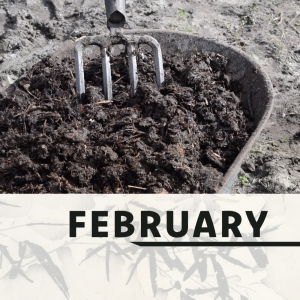
Just like the last few winter months, the soil in February is often still too cold and wet to sow or plant outside in the open ground. Though the days gradually get longer and longer, the temperature generally remains low. However, you an focus on preparations for the upcoming Spring.
First, the garden must be emptied. Usually February is the month the harvest the last of the winter vegetables, such as leeks and cabbages. This way, if the days do start to warm up, you can start with a clean slate. The cabbage stalks will take a while to decompose if thrown on the compost heap fully intact, so cut the stalks down into smaller pieces with a sharp pair of pruning shears. Do not use flower snippers for this because the stalks are quite hard and often woody. If you leave the cabbages for too much longer, you run the risk of overshooting. This means undesirable flowering, so you can no longer eat the cabbage.
You should also now have plenty of room to remove weeds. In a few weeks you will need to gently weed between all the young plants, but now the garden should be empty of all plants except weeds, so you can weed with abandon. In short, when the sun is shining, it is worth investing some time in weeding. Pull them out and place them on the compost heap. If you leave the weeds on the ground this time of year, chances are they will root again and just grow further. The soil is still so wet that the weeds will not dry out quickly. Certainly with a shower of rain, the weeds will only grow further.
In addition to emptying the garden, this is the time to consider the health of your soil. For a successful harvest, it is necessary to feed the soil. All plants that you plant in Spring need nutrients, which provide a larger harvest and better quality vegetables. Nutrients are found in, for example, decomposed manure. This can be purchased for little from an (organic) cow farmer in the neighborhood. You can also spread the compost over the garden.
If you have a grow box or unheated greenhouse at your disposal, you can start sowing a number of early crops in February. These are vegetables that can withstand the winter cold and will grow gradually despite low light and low temperatures. Think of spinach, dandelion salad, and radishes. On sunny days the temperatures in a greenhouse will rise quickly. During the colder days and nights, the plants are at least sheltered. This way the plants can grow nicely and you can pick your first salad together in a short time!
